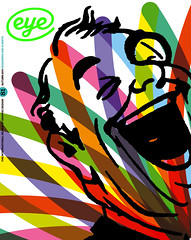Autumn 2011
Bulletins of The Serving Library #1
The Serving Library
Sternberg Press, £9<br />Editors: Stuart Bailey and David ReinfurtFollowing on from where Dot Dot Dot left off, Bulletins of The Serving Library is a new, biannual publication from the peripatetic duo (Stuart Bailey and David Reinfurt) behind the now defunct Dexter Sinister. ‘The Serving Library is a cooperatively-built archive,’ read the ‘Article of Incorporation’ written by Bailey and Reinfurt on the final pages of the first bulletin, ‘that assembles itself by publishing. It will consist of 1. An ambitious public website; 2. A small physical library space; 3. A publishing program that runs through #1 and #2.’
Appropriately, one of the articles in this first issue – a dialogue between Reinfurt and Rob Giampietro – focuses on the genealogy of the notion of the library itself. The article details how the library has developed from an ‘archive model’ (in which information is privately held) through a ‘circulating model’ (the library as we have known it since the eighteenth century) to the recent online model, which they term a ‘distributing library’. The Serving Library, Reinfurt and Giampietro claim, is an example of this last because it freely distributes its contents online.
How the bulletins operate within the overall set-up of the Serving Library is crucial, because it informs not only the contents of each one but also their distribution and use. In the ‘Article of Incorporation’, Bailey and Reinfurt go on to describe how commissioned textual and visual documents on a selected theme will be posted on the library’s website over a six-month period during which they can be accessed for free before they are then collected together to make up each bulletin. One copy will be bound in hardback and placed on a shelf in the mobile physical location of the Serving Library as it travels to different sites. There it will sit next to past issues of Dot Dot Dot and an assortment of the most frequently referenced books by contributors to the journal and Bulletins of The Serving Library.
The first point of call for the library was Banff, Canada, in the summer of 2011. Here, the books in the library were used as one of a series of tools to question the Bauhaus pedagogical model – whereby eventual specialisation in one field is the goal – that many design departments are still based upon. This process of questioning is backed up by the way the Bulletins of The Serving Library put pressure on traditional distinctions between art director, graphic design, editor and author, through the way Bailey and Reinfurt freely roam between these roles by editing both images and text, designing, and authoring many of the articles themselves.
Bulletins of The Serving Library #1, with contributions from Angie Keefer, Rob Giampietro, Bruce Sterling and the editors, addresses the twin themes of temporality and the library. Besides the two articles mentioned above, Sterling’s article on his Dead Media Project is a humorous text focusing on outmoded media. Dexter Sinister’s article (reproduced from the final issue of Dot Dot Dot) gives an account of the reasoning behind their design of a new typeface to be used in the bulletins. In other words: the pilot issue investigates its own status.
At a time when the notion of the archive, the mobile site, and relational design, are all key issues for a broad interdisciplinary community, the Serving Library and its bulletins are timely. That in many ways the bulletins are even more polyvalent – to the point of obscurity – than Dot Dot Dot will mean they are addressed to a very specific audience that can handle this degree of hyper self-reflexivity in their graphic design discourse.
First published in Eye no. 81 vol. 21 2011
Eye is the world’s most beautiful and collectable graphic design journal, published quarterly for professional designers, students and anyone interested in critical, informed writing about graphic design and visual culture. It is available from all good design bookshops and online at the Eye shop, where you can buy subscriptions, back issues and single copies of the latest issue.

